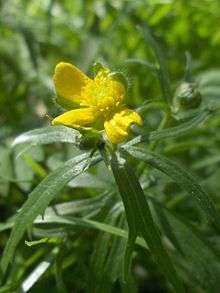Ranunculus auricomus
Ranunculus auricomus, known as goldilocks buttercup[1] or Greenland buttercup,[2] is a perennial species of buttercup native to Eurasia. It is a calcicole typically found in moist woods and at the margins of woods. It is apomictic, and several hundred agamospecies have been recognised.[1]
| Ranunculus auricomus | |
|---|---|
 | |
| Scientific classification | |
| Kingdom: | Plantae |
| Clade: | Tracheophytes |
| Clade: | Angiosperms |
| Clade: | Eudicots |
| Order: | Ranunculales |
| Family: | Ranunculaceae |
| Genus: | Ranunculus |
| Species: | R. auricomus |
| Binomial name | |
| Ranunculus auricomus | |
Description
Ranunculus auricomus is a short, slightly hairy perennial herb[3][4] which attains a height of about 40 centimetres (16 in), the basal leaves variably three-lobed. The stem leaves are few and deeply divided into 3-5 narrow segments giving the plant a filiform appearance. The flowers are frequently imperfect or distorted. They are bright yellow, the petals fall easily or absent.[1]:114
Distribution
Ranunculus auricomus is native to northern Europe and western Asia, approximately from latitudes 43 to 71 degrees and from western Ireland to the Ural Mountains.[5] In Britain it is generally a lowland species but has been recorded at 1,090 metres (3,580 ft) on Aonach Beag.[6] It is common in England and southern Scotland but becomes increasingly uncommon in the north and west, [4] so much so that, for example, it is named in the description of the Nature Reserve of Coed Garnllwyd in the Vale of Glamorgan.[7]
Habitat and ecology
Ranunculus auricomus is a perennial herb which is characteristic of deciduous woodland growing over base rich soils such as those underlain by chalk or limestone. In addition it has been recorded growing among scrub, along roadsides and in churchyards, and infrequently on open moorland in locations which are sheltered by boulders and on sheltered mountain ledges.[6] Flowering starts in April and peaks at the end of may and start of June, although these flowers attract pollinating insects the plant is incapable of being pollinated and reproduces by apomixis, the seeds developing from unfertilised ova.[3]
Taxonomy
Ranunculus auricomus is a species aggregation in which several hundred agamospecies, that is species which lack gametes, have been found with possibly a hundred or so in Britain alone.[8]
References
- Stace, Clive A. (2010). "Ranunculus L. – Buttercups". New Flora of the British Isles. Cambridge University Press. pp. 110–119. ISBN 978-0-521-70772-5.
- "Ranunculus auricomus". Natural Resources Conservation Service PLANTS Database. USDA. Retrieved 18 October 2015.
- "Goldilocks Ranunculus auricomus group". LuontoPortti / NatureGate. Retrieved 25 March 2020.
- "Goldilocks Buttercup agg. - Ranunculus auricomus agg.". NatureSpot. Retrieved 25 March 2020.
- Anderberg, Arne. "Ranunculus auricomus (L.) Sw". Naturhistoriska riksmuseet, Stockholm. Retrieved 27 May 2016.
- "Ranunculus auricomus". Online Atlas of British and Irish Flora. Botanical Society of Britain and Ireland. Retrieved 25 March 2020.
- "Coed Garnllwyd" (PDF). Wildlife Trust of South and West Wales. Retrieved 25 March 2020.
- "Ranunculus auricomus Goldilocks Buttercup". UK Wildflowers. Peter Llewellyn. Retrieved 25 March 2020.